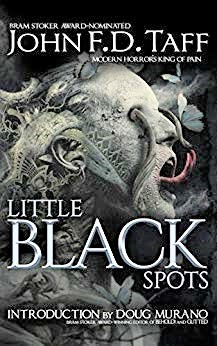by
John F. D. Taff
(Gray Matter Press, September 2018, pb, 301 pp.)
Reviewed by Victoria Silverwolf
John F. D. Taff, nominated for the Bram Stoker Award by the Horror Writers Association for his collection The End in All Beginnings, returns with another volume of dark fantasy. In addition to the eight new tales listed above, the book contains seven previously published stories, not reviewed here. Taff, known as the King of Pain for the emotional power of his fiction, demonstrates an ability to create a range of moods from terror to sadness, and even a touch of hope.
The narrator of “The Bunny Suit” seems to have a happy marriage, although he has a terrible secret that he hides from his wife. She purchases a rabbit costume for Hallowe’en, and wears it at all times. The costume soon becomes an integral part of her body, leading to tragic consequences.
The contrast between a silly costume and gruesome horror may seem ludicrous, but the author manages to maintain an eerie mood. The narrator’s hidden activities, although they add to the story’s grimness, do not directly relate to the plot.
Set during the Great Depression, “A Winter’s Tale” deals with the three children of a neglectful mother and a father who is kind but rarely seen. Each day the mother forces the children to stay outside until the sun sets, no matter the weather. The oldest child violated this rule years before the story begins, only to witness a frightening event. Told to go to a river in freezing weather, the children travel to a nearer pond instead, leading to a supernatural encounter.
This story’s realistic portrayal of unhappy childhood is more effective than its Lovecraftian menace. A hint of optimism at the end is welcome after so much suffering.
“Their Hands” is a brief, simple tale about a boy’s obsession with the beautiful hands of two girls. What happens is predictable. The style of this story is more enjoyable than its content.
“Everything Must Go” is a variation on the familiar fantasy theme of the strange little shop that appears out of nowhere. Early in the story, it becomes obvious that the shop only exists to attract victims, so the plot holds no surprises.
“Purple Soda Hand” is a bizarre story about a boy who finds an unlabeled bottle of dark purple liquid. Only after he drinks from it, and becomes addicted to the taste, does he discover a tiny severed hand inside it. The bottle never becomes empty, no matter how much is drunk from it. After sharing it with a friend, the two boys have peculiar dreams. These weird events lead to a gruesome climax.
The strangeness of this story hold one’s interest, even if the premise is absurd. The existence of the macabre bottle is unexplained, which may frustrate some readers.
“A Kiss from the Sun for Pardon” begins with a man in a motel who has lost his memory. A single clue leads him to a private nightclub, where he learns the truth. He is a vampire who is turning into a normal human. This dooms his relationship with his beloved wife, who remains a vampire. Together they agree on one final gesture of their love.
The author manages to add originality to a theme that has been greatly overused. The mood is quietly melancholy, in contrast to many melodramatic vampire stories.
“Gethsemane, in Rain” is a mysterious tale set in a small Midwestern town. Four numbered sections offer different events, some of which seem related in subtle ways. A ghost offers a warning. A chair in need of repair brings back painful memories. A dying man finds an anonymous message asking for help. A boy ponders running away from his new father.
This impressionistic story lingers in memory. Its evocative depiction of strange happenings fires the imagination.
“The Coriolis Effect (or, Chiromancy for Beginners)” features two adult brothers whose father has been dead for some time, and whose mother has recently died. Dark secrets of the past are revealed when the siblings travel together after their mother’s funeral. This tale of a very dysfunctional family is grim and violent, with no sympathetic characters.
Victoria Silverwolf started writing this review on Hallowe’en.
 Little Black Spots
Little Black Spots